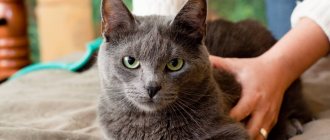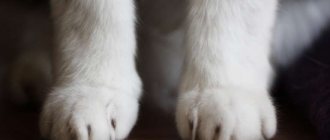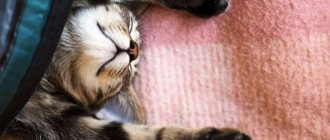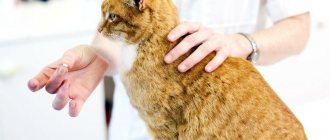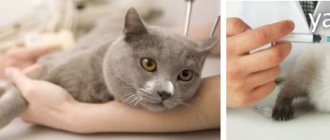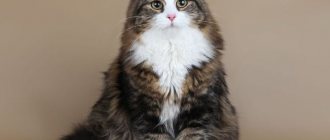Declawing cats is a very controversial procedure that causes a lot of gossip about it.
Below we will look at the reasons and indications for declawing cats, describe the procedure and provide statistics and prices. The decision to carry out this procedure or not is yours. So why bother declawing cats? In animals for which claws are their primary and most necessary weapon. Claws help cats defend themselves, move around, climb trees, run, jump, and generally lead a normal life.
The essence of the operation, recovery
“Soft paws” is a procedure for cats to remove the claws on the front limbs along with the outer phalanges of the fingers.
Sometimes owners ask to remove the claws on the hind legs, but doctors do not recommend this. The fingers form the gait, and correct posture gives the correct load on the musculoskeletal system. Onychectomy is performed under general anesthesia. The doctor removes the phalanx with a scalpel or eye pliers, being careful not to touch the pad. Sutures are placed at the cut site, and the paw is tightly bandaged. After a day, the bandage is removed and checked for bleeding or inflammation. If everything is fine, you can take your pet home.
After the Soft Paws operation, caring for your cat is not difficult:
- ensuring peace, absence of drafts and cleanliness in the room;
- appearing for dressings and control examinations at the appointed time;
- timely administration of medications - anti-inflammatory, painkillers, antibiotics, relaxants as prescribed by the doctor;
- ensuring free access to food, water, toilet. The first 2-3 weeks after declawing it will be difficult for the cat to walk, everything should be nearby;
- The protective collar will not allow you to lick the sore spot.
If there are no complications and proper care after the “Soft Paws” operation, the cat will fully recover in 3-5 months. The period of getting used to the need to walk, jump and run in a new way lasts up to 2 years. In rare cases, gait uncertainty persists forever - the older and more active the pet, the more difficult it is to adapt.
Is it possible to remove claws at all?
Based on the above facts, we can conclude that such a procedure can be carried out at the discretion of the animal owner, but is it worth risking the health and life of your tailed friend, or is it still possible to find an alternative solution to the problem of scratching furniture and people?
It’s quite possible to stop a cat from damaging furniture and scratching children while playing! There are several effective ways to help you raise an obedient cat without the bad habit of scratching:
- Buy a special accessory - a scratching post and teach your animal to sharpen its claws on this very convenient device! In this simple way you will save expensive furniture in the house and will not deprive your furry pet of its protective claws.
- Be sure to trim your cat's claws as they grow, using a special device - a nail clipper. If you find it difficult to cope with this procedure on your own, seek help from your veterinarian. Clinics perform professional nail trimming for very affordable prices.
- A cat repellent spray will help stop your cat from scratching furniture in a specific place. It has a very unpleasant odor for the animal. You can buy this product at a pet store or veterinary pharmacy.
- To prevent your cat from scratching your children, teach them to play with the animal without using physical force. As a rule, cats do not scratch without a reason; this gesture is performed solely for the purpose of self-defense.
- Special claw covers that visually resemble a nice manicure work quite effectively. Such devices will prevent your cat from scratching walls, furniture and other objects in the house. You can buy miracle pads for sharp claws at a pet store.
It doesn’t matter what kind of cat lives in your house - a British cat, a Scottish cat or an ordinary yard cat, Murka, she is a living creature that deserves your attention and care! Do not subject her to excruciating suffering, think it over several times before you decide to undergo declawing surgery!
Be sure to try using alternative methods to eliminate the annoying scratching habit. If it doesn’t help, consult with an experienced veterinarian and only then make the right decision, which will determine the future fate of your pet!
Possible complications
The first risks are associated with anesthesia. 2% of animals die, even if the patient is healthy and no mistakes were made. There is a high likelihood of an acute immune response, heart and lung problems. Possible disruption of the brain, liver and kidneys, hypothermia - entire textbooks have been written about the consequences of anesthesia.
Modern drugs and hardware monitoring during surgery significantly reduce risks. Therefore, you need to be careful when choosing a clinic, without skimping on transportation, the presence of an anesthesiologist, or hospital care.
| Complication | The essence | Frequency |
| Pain syndrome | Even soft tissues hurt after surgery, and fingers are bones, cartilage, joints, many vessels and nerves. Severe pain must be treated with opiates. | Always |
| Bleeding | There are many relatively large vessels in the fingers. The first day after the “Soft Paws” operation, cat care requires medical supervision. Often the suture is opened due to bleeding. The problematic vessel is cauterized. | Often |
| Phalanx regeneration | Instead of scarring, the amputated finger begins to grow. The claw is formed incorrectly, bent at any angle, including inside the soft tissues. Repeated surgery will help. | Often |
| Abscess | Before the procedure, the hair on the paw is not shaved. This and violation of aseptic standards leads to inflammation of the sutures, purulent lesions, and necrosis. | Rarely |
| Osteomyelitis | Purulent-necrotic inflammation of bones and bone marrow. The amputation site acts as an entry point for infection. | Often |
Long-term use of antibiotics is necessary to suppress dangerous flora. The soft tissues heal quickly - after a week the suture fuses. But when removing the phalanges, they cut directly along the bone, and it takes longer to regenerate. A competent veterinarian will insist on SSD antibiotics for at least a month to avoid local infection.
The meaning of claws in a cat’s life: “basic instinct”
Domestic cats and cats living their lives in apartment conditions are not quite the same as their wild ancestors. It is enough to turn to a simple example and draw an analogy with a private house: in the latter case, many owners allow the animal to spend time outside, and this significantly changes the essence of the issue.
What is the difference? Scratching is not just part of basic nail care. In nature, a domestic animal realizes its instincts: it hunts, snatches prey, climbs trees and, most importantly, marks its territory with the help of its claws, leaving the secretion of glands on the paw pads on the surface, thereby showing “who’s boss.”
All this allows the animal to maintain psychological balance and feel comfortable in the territory.
One of the strongest cat instincts is to mark its territory.
Pros
The Soft Paws procedure does not benefit cats; declawing only benefits owners. Without the main weapon, the ability to mark territory by tearing wallpaper, flooring, and furniture is lost. The claws do not cling to clothes, do not accidentally dig into the legs or shoulder when you take the cat in your arms or sit on your knees.
Removal of the phalanges is resorted to before the birth of a child or shortly after the birth of the baby. Parents are worried that the pet will cause injury to the newborn. Onychectomy is considered when children perceive a pet as a toy - this is easier than a long explanation of why you can’t pull a cat’s whiskers.
The advantage of declawing is the prevention of many diseases - herpes, toxoplasmosis, chlamydia, fungal infections. This is on par with the myth of warts after contact with a toad. If you delve into the topic, the absurdity is obvious. But many believe unconditionally, ignoring scientific arguments.
For example, cat scratch fever is a Bartonella infection. The bacteria are found in the saliva, urine, tear fluid and other secretions of the carrier cat. For a person to get sick, he must have low immunity. But a scratch is not necessary - bacteria still enter the bloodstream through microcracks in the skin.
When deletion is necessary
If you do not take into account the whim of the owners who take care of their furniture more than a cat, there are situations when the procedure becomes necessary.
Onychectomy is indicated for the following cases:
- The animal was found to have neoplasms in the tissues of its limbs and claws. If traditional treatment fails, your veterinarian may recommend declawing;
- The owner has a serious illness. A bleeding disorder means that even a minor injury can cause irreparable harm to a person. People suffering from this disease are advised to subject their pets to onychectomy.
Cons
For 30 years, veterinarians have studied the effects of declawing procedures on cats of different ages. It turned out that it is better to carry it out for kittens at 3-5 months, before the onset of puberty. They adapt more easily to new living conditions, the risk of blood loss is lower, the young body recovers faster, and tissues regenerate better.
But anesthesia at an early age is especially dangerous, so not all doctors risk removing the claws of cats under one year old. In adult pets, complications develop more often. However, the surgeon is expected to be concerned with immediate risks, and not long-term consequences:
- A decreased sense of balance and poor coordination develop over time due to a shift in the center of gravity. To understand how much the paw position changes, you need to pay attention to your toes while walking and imagine that they are not there. Focusing on the pads of the paws instead of the fingers grossly disrupts the functioning of the musculoskeletal system.
- Arthritis is a problem in a third of declawed cats. The cause of inflammatory processes is the increased load on the joints due to a shift in the center of gravity. The disease is chronic and requires lifelong drug therapy.
- Loss of sensitivity, atrophy of the muscles of the limbs and/or back, and spinal diseases after declawing in cats occur in 90% of cases. One or more problems, to varying degrees of severity. This is almost inevitable due to disruption of the musculoskeletal system.
- Chronic pain syndrome due to nerve deformation - constant severe pain, relieved by opiates. Treatment is only surgical.
- Bone cancer develops 1-3 years after declawing; later the risks decrease. Bumps grow on one or more fingers. If there are no metastases yet, the paw is removed. If so, euthanasia is indicated.
- High risk of injury due to lack of traction. While running and landing after a jump, the cat slows down, extending its claws slightly. When there is nothing to slow down, it slides, misses, and does not fit into turns.
- Refusal to use the litter box is observed in 40% of cats. Pain after surgery persists for weeks. They are usually tolerable, but get worse during digging. A strong connection “tray = pain” is formed. The cat relieves itself on a soft surface - furniture, things in the closet, carpet.
- Aggressive behavior and biting behavior appear in half of declawed cats. This reaction compensates for the inability to defend itself with paw strikes. Previously, tolerance was fueled by self-confidence, now a feeling of vulnerability forces one to bite in advance.
- Withdrawal, decreased activity, and mistrust develop due to unsteady gait, poor coordination, feelings of insecurity, and previous trauma. Trust in an owner is rarely lost, but now the cat prefers to stay away from everyone, literally just in case.
- Expulsion from the club, removal from the breeding program, cancellation of nursery registration, other punitive measures depending on the system. Declawed cats are not allowed to participate in exhibitions by all international felinological organizations.
Vulnerability can cost lives. If a pet goes outside after an onychectomy, it will not be able to hide in a tree from a dog or slap an aggressive cat. It is important to ensure that the cat with the phalanges removed does not accidentally run out into the entrance or fall out of the window. Free range is excluded.
Alternative to cat declawing surgery
If onychectomy is not associated with diseases of the claws and phalanges of the fingers, the pet owner should consider all possible alternatives to this operation.
Anti-scratch
Anti-scratch caps are caps for cat claws made of silicone. They are held on the claws using special glue. Despite the presence of anti-scratch pads, the cat leaves the opportunity to release its claws whenever it wants. In addition, pets have a need to sharpen their claws; anti-scratch pads will not interfere with the process, but the furniture will not be damaged, as will the owner’s hands.
Anti-scratch caps are special silicone caps that are placed on a cat’s claws and secured to them with special glue.
The caps cause virtually no discomfort, and the animal can live a full life without limiting its habits. If the cap suddenly falls off and the cat swallows it, it will not cause harm to the pet. Today, anti-scratch products are presented in a wide selection, which makes it possible to choose a suitable option for both a kitten and an adult animal.
Video: how to put on anti-scratch pads for a cat
Trimming
Trimming your pet's nails should normally be done every tenth day. To do this, you need to use a special nail clipper. Each claw is trimmed to just 1 mm. Exceeding this level is prohibited, otherwise bleeding can be provoked. To accustom your pets to nail trimming, the procedure must begin at an early age.
It is necessary to cut off the tip of the claw so as not to damage the blood vessels
Scratching posts
In order to solve the problem of damage to furniture and interior items, it is enough to acquire a special scratching post. It will take some time to get used to it. When your pet starts scratching the furniture, you need to say “No!” in a stern tone. and carry the cat to the scratching post. In this case, you need to take the cat’s paws in your hands and make several characteristic movements. You can also use catnip for training.
It would also be a good idea to play with your pet near the scratching post so that during play he clings his claws to the surface intended for sharpening his claws. Cats quickly understand that this can and should be done here, and they leave the furniture alone.
A scratching post is a necessary attribute of keeping an animal.
Video: how to choose a scratching post and train your pet to use it
Legality
Cosmetic veterinary surgery is popular in the United States - animals have ligaments cut, piercings, and implants inserted. But even in their historical homeland, the “Soft Paws” procedure is abandoned due to the negative impact on health and quality of life. Declawing without indication has already been banned in 12 states.
In European countries, onychectomy without medical indications has long been prohibited; it is considered intentional mutilation. This is not a subjective attitude, but a legal definition of the essence of the process. A complete ban applies in the following countries:
- Great Britain
- Netherlands
- Germany
- Denmark
- Sweden
- Finland
- Norway
- Australia
- Israel
- Brazil
- Portugal
- Czech
- Serbia
- Belgium
- France
- Italy
- Spain
- Ireland
In Russia, a project to ban euthanasia, cupping and onychectomy without indications is under development. It will complement the already adopted Responsible Animal Welfare Act. Many breeders stipulate a ban on the removal of phalanges in the sales contract, but it is difficult to track its implementation. About a third of Russian clinics do not provide this service.
Safe Alternatives
The problem with torn wallpaper and furniture is easy to solve - the cat needs a play complex with tunnels, several levels, hammocks, and posts. It's expensive, but if you want, you can assemble it yourself - nothing complicated. Cats will love mint scratching posts if they reward their use with a tasty piece.
Silicone pads will help out as a temporary solution for the period of re-education. They also change their gait. Under the hood a favorable environment is created for the development of fungi and bacteria. The cat might swallow the pad, but it depends. But this is not as dangerous as the consequences of onychectomy.
They fight aggression in a comprehensive manner - they turn to veterinarians, ask for advice from experienced breeders. If you find the reason for the lack of trust in your hands, you won’t have to remove the cat’s claws. When there is no time or desire to solve the problem in another way, it may be worth considering the option of transferring the cat into good hands.
It is important to recognize that a domestic cat's behavioral problems are the fault of humans. Even if there was a good reason, it was the person who didn’t look, missed, or didn’t find the time to correct behavior right away when it was easy. It's not fair that animals are responsible for our mistakes.
At what age should a kitten be declawed?
Veterinarians do not impose such a requirement on the age of a kitten to perform such an operation. The main thing here is that the pet is healthy enough so that it can tolerate anesthesia. Therefore, before performing an onychectomy, it is imperative to undergo an examination.
However, many veterinarians set a lower age limit for when a kitten needs to be declawed. This is not earlier than eight months of age. It is at an age above this threshold that the cardiovascular system has become stronger and the kitten will more easily endure the anesthesia itself and the recovery from it.
